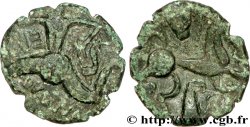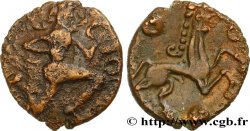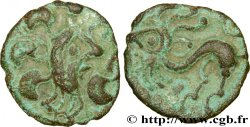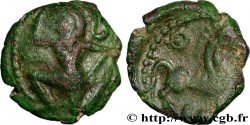bga_209369 - GALLIA BELGICA - BELLOVACI (Area of Beauvais) Quart de statère d'or à l'astre, cheval à gauche
Not available.
Item sold on our e-shop (2012)
Price : 450.00 €
Item sold on our e-shop (2012)
Price : 450.00 €
Type : Quart de statère d'or à l'astre, cheval à gauche
Date: c. 80-50 AC.
Mint name / Town : Beauvais (60)
Metal : gold
Diameter : 12,00 mm
Orientation dies : 3 h.
Weight : 1,47 g.
Rarity : R3
Coments on the condition:
Petite monnaie frappée sur un flan assez large pour avoir les types complets. Une légère fissure du métal, visible au droit au niveau de l'astre et au revers, devant la tête du cheval
Predigree :
Cet exemplaire provient de la collection A.C.G. et précédemment de la vente BURGAN du 6 décembre 1996, n° 25. Avec l’exemplaire n° 21 de la vente BURGAN du 2 juillet 1988 issu des mêmes coins, ces deux monnaies proviennent probablement d’un même petit ensemble (?)
Obverse
Obverse legend : ANÉPIGRAPHE.
Obverse description : Restes de tête humaine à droite, le gros œil orné d'un astre et une esse devant la bouche ; gris grènetis autour.
Reverse
Reverse legend : ANÉPIGRAPHE.
Reverse description : Cheval libre galopant à gauche ; au-dessus et au-dessous, un soleil.
Commentary
Si les quarts de statères de la classe II (avec le cheval à droite) sont connus en assez grand nombre, S. Scheers n’avait répertorié que 4 exemplaires avec le cheval à gauche ; l’exemplaire BN 7236, le n° 308 de Péronne, un à Bruxelles et un dernier à l’ANS.
Cet exemplaire (au revers très proche du BN. 7236) a la particularité d’avoir un droit très convexe et un style particulier. Le revers donne quand à lui l'impression d’une monnaie scyphate (comme ce monnayage en argent) et est issu d’un coin fatigué !.
Cet exemplaire (au revers très proche du BN. 7236) a la particularité d’avoir un droit très convexe et un style particulier. Le revers donne quand à lui l'impression d’une monnaie scyphate (comme ce monnayage en argent) et est issu d’un coin fatigué !.








 Report a mistake
Report a mistake Print the page
Print the page Share my selection
Share my selection Ask a question
Ask a question Consign / sell
Consign / sell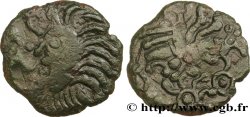
 Full data
Full data